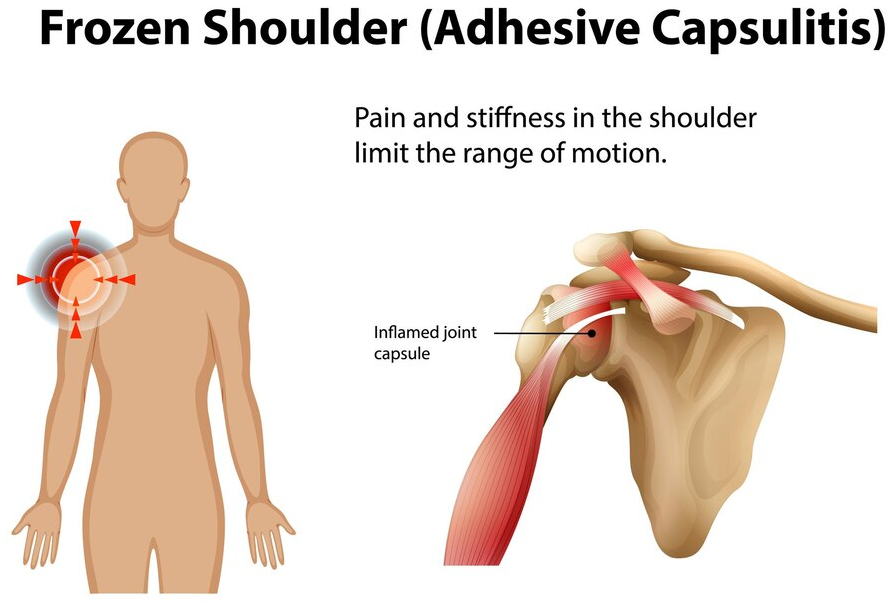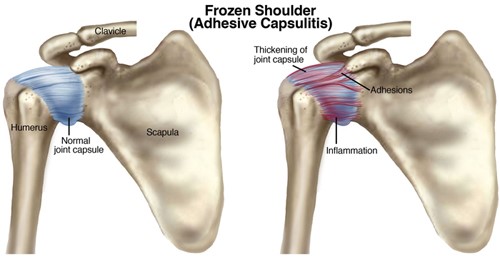If you’ve ever experienced pain and stiffness in your shoulder, you know how difficult it can make everyday tasks—reaching for something on a shelf, putting on a jacket, or even combing your hair. One possible reason for this kind of shoulder pain is frozen shoulder, also known as adhesive capsulitis.
In this blog, we’ll break down what frozen shoulder is, how it happens, and how Physiotherapy Treatment can help you recover and regain full use of your shoulder.
What is a frozen shoulder?
Frozen shoulder occurs when the tissue around your shoulder joint (called the “capsule”) becomes inflamed, thickened, and tight. Consequently, this makes it harder to move your shoulder and causes pain. In some cases, the pain can also get worse at night, making it difficult to sleep. Usually, this condition develops slowly, often over the course of months or even years, and in a predictable pattern. Unfortunately, frozen shoulder can be quite limiting in daily life. Thankfully, with the right approach, most people can recover and get their shoulder moving again.
What causes frozen shoulder?

Currently, the exact cause of frozen shoulder isn’t known. However, there are a few things that have been associated with an increased risk of developing it:
- Injury or surgery: After a shoulder injury, fracture or surgery (like a rotator cuff repair), there are usually a time where the shoulder is immobilized. Thus, the shoulder may become stiff from lack of movement and there is an increased risk of developing frozen shoulder during this time
- Medical conditions: People with diabetes are more likely to develop frozen shoulder. Additionally, thyroid conditions, heart disease, or even Parkinson’s disease can also increase the risk
How Do You Know If You Have Frozen Shoulder?
The main signs of frozen shoulder are:
- Pain: You may feel pain in the shoulder, especially when you try to move it. Also, it tends to be often at night or when you try to lift your arm up
- Stiffness: You may notice that you can’t move your shoulder as freely as you used to. Simple tasks like reaching behind your back or lifting your arm may become difficult
- Limited Range of Motion: The stiffness usually leads to a limited range of motion, especially in external rotation (with your elbow bent to 90, try rotating your arm outwards like you’re pushing open a curtain). Additionally, you may not be able to raise your arm above your head or reach out in front of you as easily
Frozen shoulder usually develops in three stages lasting around 1-3 years overall:
- Freezing stage: First, pain starts to increase while shoulder movement begins to reduce. Usually, this stage lasts about 3 months
- Frozen stage: Then, in the next 6 months the pain might reduce while stiffness greatly increases. At its worst, you may not be able to move the shoulder much
- Thawing stage: Finally, lasting anywhere from 6 months to a couple years the shoulder will spontaneously improve over time. Gradually, the shoulder starts to loosen up and movement improves
How can Physiotherapy help?
While frozen shoulder can feel frustrating, Physiotherapy Treatment is recommended effective for helping you recover from a frozen shoulder. They will work with you to improve your shoulder’s mobility/function and reduce pain. Here’s how physiotherapist can help:
1. Pain relief techniques
Physiotherapists may use techniques like heat therapy, ice packs, ultrasound, electrotherapy to reduce pain and inflammation. These methods can also help loosen up the shoulder muscles to make it easier to stretch and move
2. Gentle stretching and mobilization
At first, your Physiotherapist will use gentle stretches to help increase your range of motion. These stretches will focus on improving flexibility and reducing stiffness. Over time, they will progress to more intense stretches as your shoulder becomes more mobile
3. Strengthening exercises
Once the pain is under control and your range of motion has improved, strengthening exercises will be introduced. Importantly, these exercises help build muscle around the shoulder to support the joint and prevent future injuries. After a long period of disuse in the shoulder, strengthening is key to restoring it to full function
4. Education and Advice
Additionally, your Physiotherapist will give you advice on how to avoid aggravating your shoulder and help you learn how to move in ways that prevent excessive pain. Furthermore, they’ll teach you simple exercises to do at home to keep your shoulder moving and improve its flexibility.
How Long Does It Take to Recover?
The timeline for recovery can vary from person to person. It can take several months to years for your shoulder to fully recover from frozen shoulder. Typically, the process is broken down into stages, as mentioned before. The key is consistency. Regular physical therapy, along with exercises at home, can help speed up the recovery process. But, it’s important to be patient and stick to your rehabilitation plan.
Frozen shoulder can be a painful and frustrating condition, but with the right physiotherapy treatment, you can regain full use of your shoulder. If you’re experiencing shoulder pain or stiffness, don’t hesitate to contact us at PhysioNow. We will help you develop a personalized treatment plan that will get you back to doing what you love—pain-free!
Remember, the earlier you start treatment, the better the recovery outcomes. If you have any questions or would like to book an appointment, feel free to reach out to PhysioNow today!





